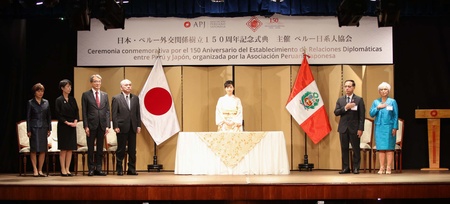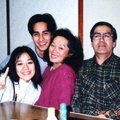2024 will be a big year for the Nikkei community in Peru because it celebrates the 125th anniversary of Japanese immigration to the country.
But before getting there, it is worth stopping for a while in 2023 whose echoes can still be heard, a special year for the governing institution of the Peruvian Nikkei, the Peruvian Japanese Association (APJ).
Its president, Juan Carlos Nakasone, looks back to share his memories and impressions about a period full of experiences to frame.
ROYAL VISIT
In 2023, Peru and Japan celebrated 150 years of diplomatic relations. Both governments were in charge of the commemorative events, with the support of the APJ every time it was called.
Its president fondly remembers the visit to Peru in November of Princess Kako, daughter of Crown Prince Fumihito, to participate in activities related to the anniversary.
“It was a lovely surprise,” he says, alluding to the fact that his presence in the country was confirmed at the last minute.
In his packed agenda, which included a meeting with the president of Peru, the Nikkei community occupied a relevant space.
The princess visited the Peruvian Japanese Cultural Center (CCPJ), where she interacted with Nikkei leaders and had a pleasant exchange with the Issei Kamado Arakaki, 104 years old. Kako crouched down to facilitate communication with the obaachan and she – her hands intertwined with those of the young woman – told her in broad strokes about her life as an immigrant.

Kako also planted a pine tree in the CCPJ garden, maintaining a tradition that was inaugurated by the then crown princes Akihito and Michiko (his grandparents) in 1967, the year the cultural center opened, and that was continued several decades later by his parents and his sister. Mako.
The Peruvian-Japanese Friendship Bridge is an unavoidable stop when it comes to remembering or honoring Japanese immigrants (it has the names of the 790 Issei with whom the history of the community began in 1899 inscribed) and the princess also visited it, leaving a floral offering as a testimony of their attendance.
In reality, Juan Carlos Nakasone already knew the princess. His first meeting with her was in October, when he led an APJ delegation that traveled to Japan to receive, on behalf of the institution, the Japan Foundation award, the other great event that marked his mandate.
AWARD IN TOKYO
A combination of “pleasure, surprise and pride” meant that the APJ – explains its top executive – received the Japan Foundation award for merits such as the dissemination of the Japanese language in Peru, the transmission and promotion of Japanese culture, its services health, its social activities and its contribution to strengthening relations between both countries.

The Japan Foundation also recognized the editorial work of the APJ, materialized, to mention one case, in the first direct translation from Japanese to Spanish of the classic work The Tale of Genji , a work that has been in demand from other countries, including Spain. .
When an institution receives a distinction, those who usually appear in the photos and wear the medals are the directors. In the case of the APJ, however, a group of workers with many years of experience in the institution and fully identified with it was mobilized to Japan so that they could also receive applause.
Juan Carlos Nakasone always ponders them. They are “those who stand up and offer the services that the institution provides to the community in general, in the cultural, educational, healthcare, and health areas.”
During his stay in Japan, the president of the APJ offered a conference on the institution and the history of Japanese immigration to Peru.
Among the listening public was an illustrious guest, who was incognito in an adjoining room: Princess Kako.
The Peruvian delegation was informed of their presence, as well as their interest in greeting the members of the institution.
“She proved to be a quite jovial, simple person. She extended her hand to all of us, even though we had previously been told that we should save the greeting and only bow, but she took the initiative and—with great pleasure—we all extended her hand to her.” “We extended our hand,” recalls the president.
Kako greeted each member of the APJ one by one and asked about the task they were carrying out. He was surprised when he learned that one of them, Justino Páucar, events coordinator, has been working at the institution for 47 years.
He asked Juan Carlos Nakasone about his grandfather. Paying attention to his presentation, the princess had heard that her ojiichan had also presided over the APJ when it was called the Central Japanese Society.
TRAVEL TO JAPAN TO ATTRACT YOUNG PEOPLE
Another fact to highlight from his administration was the revelation that the Nikkei population in Peru is much larger than estimated. Thanks to an agreement with the public body in charge of identifying all Peruvians, it was learned that in the country there are around 200,000 people with Japanese ancestors.
There are at least six generations of Nikkei.
This generational diversity implies, in the opinion of the president of the APJ, a challenge.
“We Sansei still carry the culture received from the Ojiichan, but the Yonsei has not had, has not enjoyed the direct transfer from the Issei,” he warns.
“It is the sansei who transmit to them the baggage received, but it is not the entirety, so we are losing a little of the original identity and we are identifying more with the national (identity), where we live together and carry out our daily lives,” he adds.
“The idea is precisely, to the extent possible, to be able to transfer as much of the cultural baggage that one receives. I have always said that the Issei are luminaries who have transmitted their culture to us...And this culture has even changed with respect to Japan, they don't even live it anymore, but we continue to transmit it."
Here, the sansei, laughing, gives as an example the use of words that Japanese immigrants passed on to their descendants, such as “obenyo” (bath), which are no longer used in Japan today.
At the Japanese embassy, he says, they are surprised when they learn that the Nikkei maintain ancient Japanese expressions or customs that have disappeared in Japan itself.
In relation to the above, the president of the APJ shares a unique experience that he lived in Okinawa, the land of his ancestors, in 2023.
Juan Carlos Nakasone was received by officials from the southern prefecture, led by the Okinawan vice governor.
In the middle of the meeting, he told them that the Peruvian Uchinanchu community needed “spiritual advisors” (yuta) to guide its members on how to properly carry out butsudan, since those it had had died.
At first, he recalls, the Okinawans took his request “jokingly,” but then they reflected on it and accepted it.
The anecdote serves to show how there are Nikkei in Peru who devotedly maintain the traditions inherited from their ancestors.
Returning to young people, Juan Carlos Nakasone insists on the need to strengthen Nikkeidad in the new generations, an objective that requires a constant effort to attract them to community life.
He gives as an example his own daughter, whom he always seeks to persuade to participate in Nikkei institutional activities.
The president of the APJ is convinced that an effective way to capture the interest of young people is for them to travel to Japan.
She experienced it firsthand with her daughter, who had the opportunity to visit Japan and fell in love with the country, to the point of expressing that she would like to live there.
Japan, he says, must relax its border restrictions to facilitate the visit of Peruvians to its territory; It's a topic he always raises when he meets with Japanese embassy officials.
“We need our young people to be able to go to Nihon. It is an important way for them to acquire roots, recognize their descent and identify themselves,” he says.
His more than 20 years as part of the APJ in all its levels allow him to affirm with certainty that this works: "I am a witness and I attest that young people when they go to Japan fully identify with their descendants."
“I think that Japan's contribution to overseas Nikkei communities is to make it easier for members of our community to visit Japan, identify themselves, have an experience, so that this continues to flow within our communities, because there has to be a starting point of identification. We no longer have the issei, we no longer have the obaachan. Our contribution to cultural transfer could be deepened with the children's visit to Japan,” he emphasizes.

OJIICHAN AND OBAACHAN IN REMEMBERMENT
The year of the 150th anniversary has been followed by the 125th anniversary of Japanese immigration, an occasion like graffiti to remember the Issei.
The president of the APJ was not able to meet his maternal grandfather, but he was able to meet his paternal grandfather, who was president of the Central Japanese Society. “Like all Japanese, harsh, even dictatorial, but everyone paid him their respect, no one questioned his orders,” he says.
From his ojiichan he learned the value of work. The Nakasone had a bazaar in the center of Lima, on the first floor of a building that functioned as a home on the second floor.
“We worked morning, afternoon and night,” he remembers. Thanks to that work he was able to finance his university studies
It was also his grandfather who instilled in him his vocation for service, his attachment to Nikkei institutions. Young, with a brand new driving license, he became his ojiichan's driver. I took him to the Peruvian Japanese Cultural Center for the activities of the Central Japanese Society, waited for him while they were taking place and took him back home when they were finished. Thus, little by little, he began to become familiar with the institution.
On the other hand, he remembers his obaachan as “a bread of God”, with great affection. “I was Chonan, so I think I was the cocky one,” he laughs.
“I miss the Okiwanese dishes he prepared, ashitibichi, his daikon pickles...,” he recalls.
His grandmother played shamisen, an instrument that he keeps, as well as his daikon grater, his personal treasures.
Talking about his grandparents — who communicated with each other in Nihongo and Uchinaguchi — resurrects a memory that many Nikkei will identify with:
“In the past in Lima it was customary to close businesses and make hirune. Since we lived on the second floor, all the employees gathered and we had lunch together. I remember that at one o'clock, I think, the radio was turned on to listen to Radio Inca and especially the obituary, to see who died. Although Peru Shimpo was received, it was traditional to turn on the radio, listen to music and then the deaths," he recalls, alluding to a radio program where Japanese music was broadcast, information was provided on the activities of the community and, as a culmination, the people who had died.
Obituaries have always been important to the Nikkei, who to this day maintain the custom of bringing envelopes of money to funerals.
EPILOGUE
In the final stretch of his mandate, Juan Carlos Nakasone says that he did not imagine that he would lead the APJ: “I am honest with you, I did not think about presiding over the institution because, as they say, not everyone becomes general. But the opportunity, the space, was given, and without wanting to, I had to preside over the institution in quite important celebratory activities.”
It has been “a family, personal pride,” he adds. Final point for a management that says goodbye after a historic year.
© 2024 Enrique Higa Sakuda





